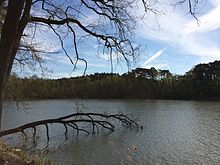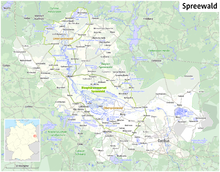Heath lakes
The Heideseen are a small lake district south of the Märkisch Buchholz district of Köthen in the Brandenburg district of Dahme-Spreewald in Germany .
geography
The lake group consists of the Pichersee , the Mittelsee , the Triftsee and the Schwanensee as well as the Schibingsee and the Großer Wehrigsee . The Small Wehrigsee is largely in recent years silted . The lake area is embedded in the northern foot of the Krausnicker Mountains . All the lakes are relatively small, with ten hectares the Swan Lake is the largest and with a depth of eight meters also the deepest of the lakes.
Formation of the lakes
The formation of the Heideseen is related to the ice edge of the Brandenburg stage of the Vistula glaciation , which was here around 20,000 years ago and whose terminal moraine includes the Krausnicker Mountains. South of the Heideseen there was a glacier gate and the end of an extensive channel that can be followed to the northeast as far as the Scharmützelsee . The meltwater escaping at the glacier gate spilled numerous blocks of dead ice . After the ice blocks had thawed out, the lakes were created at the end of the Vistula Ice Age . The 144 m high Wehlaberg is only about 550 m southeast of the Schwanensee. Over this short distance, the terrain rises by almost 100 m.
General
The Heideseen are designated as a nature reserve (excluding the Small and Large Werigsee) and, together with the Köthener See and the Krausnicker Mountains, belong to the northwesternmost area of the Spreewald Biosphere Reserve . The lake district only covers an area of around 1.5 km², is fed from the groundwater of the Krausnicker Mountains and drained via small rivers into the Köthener See and from here into the river and canal system of the Dahme . The heather lakes are completely lined with forest, only at the northern end of the Pichersee there is a horse stud .
The two Wehrigseen, lying within a separate nature reserve, have flat, vermoorte bank and are of conical swamp forests surrounded. The Kleine Wehrigsee is almost completely silted up. The other lakes have more or less sloping banks, only narrow and sparse reed belts and are surrounded by pine - sessile oak - mixed forest. Overall, the area of the lake district has a highly differentiated relief with small flat areas, erosion valleys and steep slopes. In the adjacent forests there are still isolated remnants of original sessile oak communities.
The southeastern Heideseen Picher, Mittel-, Trift- and Schwanensee are DAV waters.
Chemical and trophic characteristics
The Schibingsee is a weakly mesotrophic body of water with an average total phosphorus content of 9.3 to 17 µg / l .
The Pichersee is a eutrophic lake, its total phosphorus concentration is between 31 and 55 µg / l. It was considered extremely acidic in the past, but is now back in a weakly alkaline state.
The trophic classification is based on the indication of the remains of planktonic diatoms in the profundal mud .
See also
Web links
swell
- Paleolimnian model construction and biocene-based assessment approaches for river lakes using the example of diatoms (= specialist articles by the State Environment Agency . Issue No. 93, 2005. PDF file, 2 MB).
- For the formation of the Heideseen and the Krausnicker Mountains cf. Cape. 4.2.4: The ice edge in the Oderin Basin and on the Krausnicker Platte (p. 64ff). In: Olaf Juschus: Das Jungmoränenland south of Berlin - Investigations into the young Quaternary landscape development between Unterspreewald and Nuthe. Dissertation Humboldt University Berlin 2001, doi : 10.18452 / 14585 .
Coordinates: 52 ° 4 ′ 5 ″ N , 13 ° 47 ′ 54 ″ E




